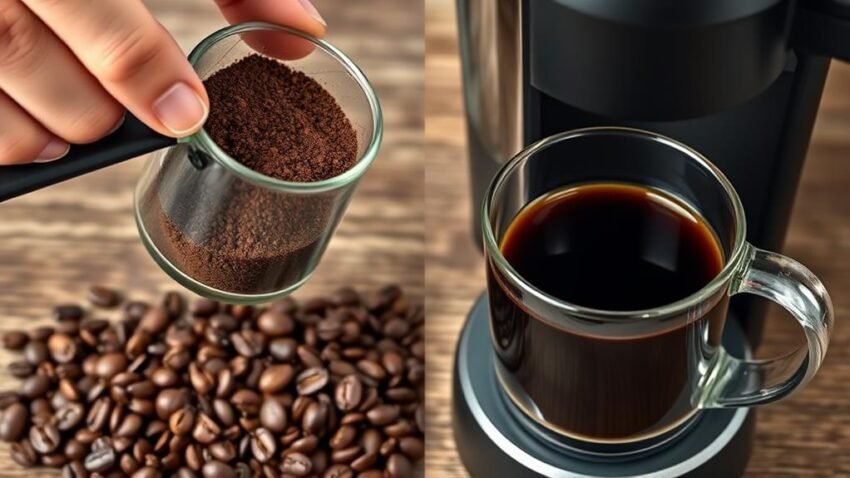Making half decaf coffee is an art that's nearly impossible to master, but I'm here to guide you through it. For those of us who love the rich flavor of coffee but find full-strength brews too intense, half decaf offers a perfect balance. To start, you'll need to choose high-quality caffeinated and decaffeinated beans—equally splitting them for that ideal 50/50 blend. Make sure you pre-mix these beans before grinding to maintain consistency. But that's just the beginning; how you blend and brew these beans can make all the difference in achieving a smooth, balanced flavor. Let's delve into the nitty-gritty details so you can craft your perfect cup.
What Is Half Caff Coffee?
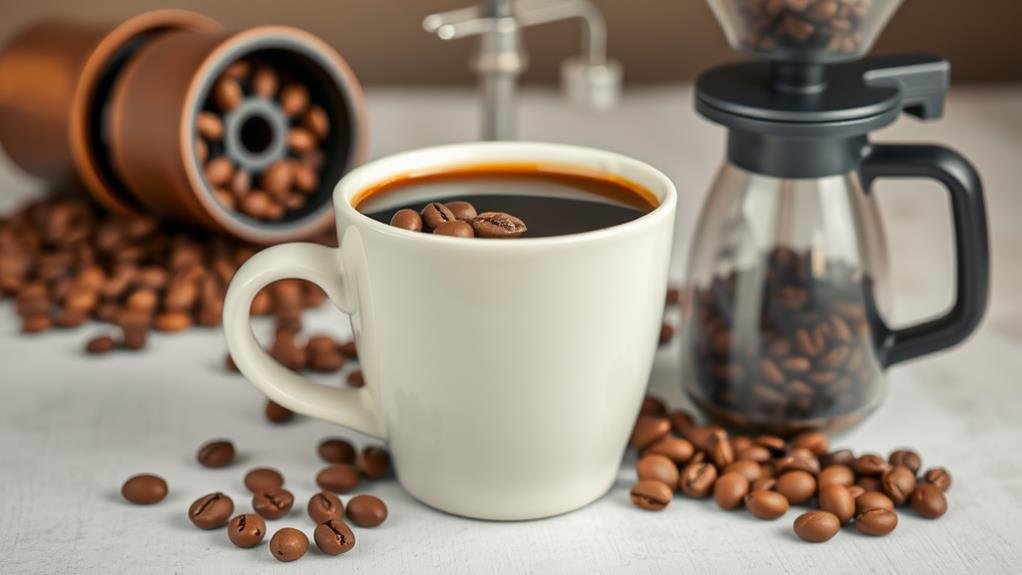
Half decaf coffee is primarily a blend of both caffeinated and decaffeinated coffee beans, typically mixed in a 50/50 ratio. This blend offers a balance between the full flavor of regular coffee and the reduced caffeine content of decaf, making it ideal for those who want to cut down on their caffeine intake without sacrificing taste. The half decaf blend contains half the amount of caffeine found in a regular cup of coffee, making it a perfect compromise.
One of the key advantages of half decaf coffee is that it uses the same type of beans for both the caffeinated and decaffeinated components. This consistency guarantees that the flavor profile remains familiar and enjoyable, much like what you'd experience with a full-strength cup but with less caffeine. In some coffee shops, half decaf is also known as a split shot or half and half, appealing to customers who seek to moderate their caffeine consumption.
For those looking to make half decaf coffee at home, it's quite straightforward. Simply blend equal parts of caffeinated and decaffeinated beans when brewing, and you'll have a delicious and balanced cup that suits your needs. This approach allows you to enjoy high-quality coffee with adjustable caffeine content.
Benefits of Half Caff Coffee
When I drink half caff coffee, I appreciate the reduced caffeine intake it offers, which is especially beneficial for managing my overall caffeine consumption. Additionally, half caff coffee maintains a complex flavor profile that satisfies my taste buds without the full jolt of caffeine. This balanced approach also comes with health benefits, making it a great option for those who want to enjoy coffee while keeping their caffeine levels in check.
Reduced Caffeine Intake
Reducing my caffeine intake has become a priority, and that's where half decaf coffee comes in. Half decaf coffee is an excellent option for those looking to cut down on their overall caffeine consumption without giving up the rich taste and aroma of regular coffee. By containing half the caffeine of regular coffee, half decaf offers a balanced reduction that makes it easier to manage my daily caffeine intake.
Drinking half decaf coffee allows me to enjoy a flavorful cup while notably decreasing the amount of caffeine I consume. This is particularly beneficial for individuals who are sensitive to caffeine or need to manage their intake for health reasons. For instance, if you're someone who likes to drink multiple cups of coffee throughout the day but want to avoid excessive caffeine, half decaf is a perfect compromise. It provides the same delightful coffee experience but with a much lower caffeine content. This makes it an ideal choice for anyone aiming to reduce their caffeine intake without sacrificing the enjoyment of their daily cup of coffee. By switching to half decaf, I can indulge in my love for coffee while keeping my caffeine levels in check.
Complex Flavor Profile
Switching to half decaf coffee not only helps me manage my caffeine intake, but it also enriches my coffee experience with a more intricate flavor profile. Half decaf coffee combines both caffeinated and decaffeinated beans, creating a unique taste that retains the characteristics of the original coffee blend. This balance allows for a richer and more nuanced flavor compared to full decaf coffee.
When I opt for half decaf coffee, I'm enjoying a blend that offers the best of both worlds. The mixture of equal parts caffeinated and decaffeinated beans guarantees that the coffee doesn't lose its robust flavors. Instead, it presents a harmonious blend where each bean type complements the other, resulting in a smoother and more balanced taste.
This complexity in flavor makes half decaf coffee an appealing option for those who want to reduce their caffeine consumption without sacrificing the rich taste of regular coffee. It's a perfect compromise between decaf and regular coffee, offering a satisfying and flavorful drinking experience. By choosing half decaf coffee, I can indulge in the full-bodied taste of coffee while maintaining control over my caffeine intake. This makes it an ideal choice for anyone looking to enhance their coffee experience.
Health Benefits
By opting for half decaf coffee, I can significantly reduce my caffeine intake without giving up the rich flavors I love. This blend offers half the caffeine of regular coffee, which can notably lower the risk of caffeine-related health issues. For instance, excessive caffeine consumption can lead to anxiety and jitters, but half decaf coffee can help alleviate these symptoms.
Choosing half decaf coffee provides a good compromise between enjoying the full flavor of my favorite brew and reducing my overall caffeine intake. This is particularly beneficial for those who are sensitive to caffeine or want to maintain a healthier balance in their daily coffee habit. By cutting down on caffeine, I may also experience fewer side effects such as an irregular heartbeat or sleep disturbances.
Incorporating half decaf coffee into my routine allows me to enjoy the complex flavor profile of coffee while being mindful of my health. It's a simple yet effective way to balance my love for coffee with the need to manage my caffeine consumption wisely. This choice not only enhances my coffee-drinking experience but also contributes to a healthier lifestyle.
Choosing the Right Beans
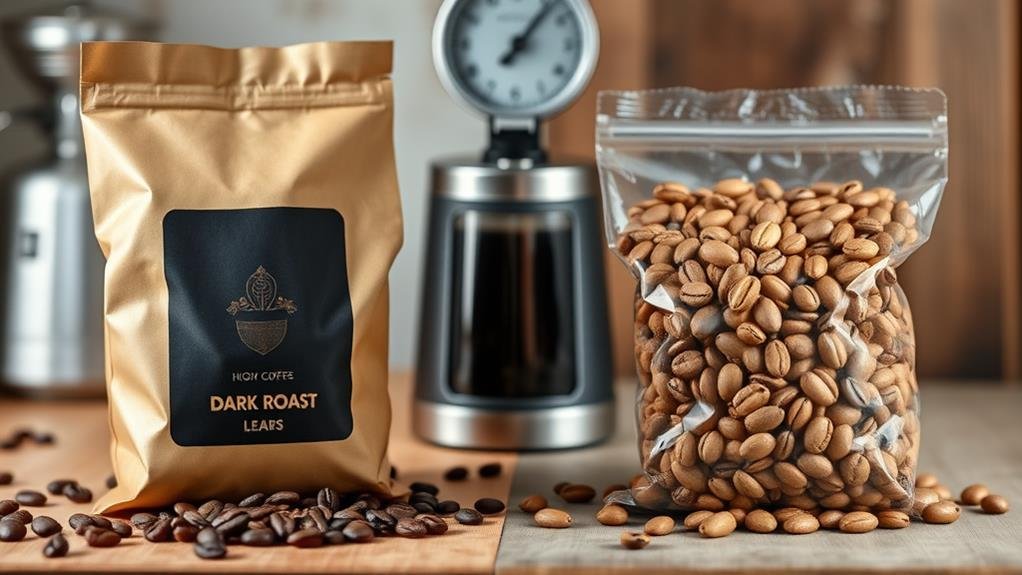
When it comes to making half caff coffee, selecting the right beans is important. You want to guarantee that your blend of caffeinated and decaffeinated beans offers a balanced flavor profile. Here's how you can choose the best beans for your half caff coffee:
Key Considerations for Choosing the Right Beans
| Factor | Caffeinated Beans | Decaffeinated Beans |
|---|---|---|
| Quality | High-quality for balanced flavor | High-quality for balanced flavor |
| Roast Level | Similar to maintain consistency | Similar to maintain consistency |
| Origin | Single origin for complexity and depth | Single origin for complexity and depth |
To create a great half caff blend, look for high-quality caffeinated and decaffeinated beans that are of similar roast levels. This guarantees that the flavors mix well together without any jarring notes. Single origin beans can add complexity and depth to your coffee, making it more interesting and enjoyable. Experiment with different origins and blends until you find the combination that suits your taste best. Finally, grind the beans together right before brewing to guarantee a well-mixed and flavorful half caff coffee. This step will help you appreciate the full potential of your carefully selected beans. By following these guidelines, you'll be able to craft a delicious half caff coffee that meets your standards.
Blending Methods Explained
When it comes to blending half caff coffee, you have two main approaches: pre-mixing beans before grinding and using separate grind methods. Pre-mixing guarantees a consistent blend by combining equal parts caffeinated and decaffeinated beans before you grind them. Alternatively, you can mix the grinds of regular and decaf beans separately, which allows for more flexibility in adjusting the blend to your taste preferences.
Pre-Mixing Beans
To make half decaf coffee, start by pre-blending your beans. This method involves mixing equal parts of regular and decaffeinated beans before grinding them. By doing so, you guarantee an even distribution of caffeine levels throughout the coffee grounds, which is essential for a consistent half decaf blend every time you brew a cup.
Pre-blending beans also allows you to achieve a well-rounded flavor profile in your half decaf coffee. Here's a breakdown of what you need to ponder:
| Aspect | Benefit |
|---|---|
| Caffeine Level | Consistent caffeine dispersion |
| Flavor Profile | Well-balanced and uniform taste |
| Ease of Use | Simple to mix beans before grinding |
| Customization | Experiment with different ratios to find your preference |
When pre-blending, feel free to experiment with different ratios of regular and decaf beans to find your preferred caffeine level and taste. This flexibility is one of the key advantages of pre-blending beans, ensuring that you can customize your half decaf coffee to suit your preferences perfectly. By blending the beans before grinding, you are guaranteed a consistent and flavorful cup every time.
Separate Grind Methods
After pre-mixing your beans, another approach to making half caff coffee involves grinding regular and decaffeinated beans separately before blending them. This separate grind method offers several advantages that can enhance the flavor and balance of your half decaf blend.
By grinding each type of bean individually, you gain more precise control over the grind size and extraction process. Here are some key benefits of this method:
- Precision Grind Control: Tailor the grind settings to each type of bean.
- Consistent Extraction: Ensure consistent extraction for both regular and decaf coffee.
- Flavor Balance: Enhance the overall flavor and balance of your half decaf coffee blend.
- Customization: Allow for adjustments based on the specific characteristics of each bean type.
This technique allows you to optimize the grind for each bean, which is important because regular and decaf beans may have different ideal grind sizes. By doing so, you can achieve a more balanced and flavorful half decaf coffee. This method is particularly useful if you prefer a nuanced taste profile in your half decaf blend.
Brewing Techniques for Half Caff
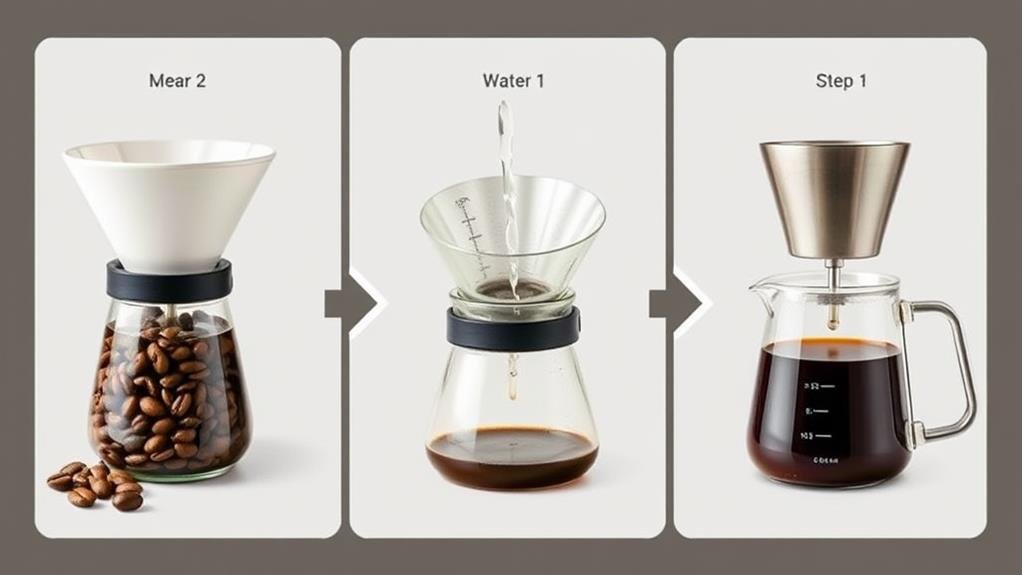
Brewing half decaf coffee involves a few key steps to guarantee the perfect balance of flavor and caffeine. First, make sure you have a 50/50 mix of regular caffeinated coffee beans and decaffeinated beans. Grind these beans together to achieve an even distribution of flavors and caffeine levels. This mixing is essential because it results in a coffee with half the caffeine content of a regular cup.
When brewing, use your preferred method—whether it's a French press, drip coffee maker, or pour-over. The key is to maintain the 50/50 ratio consistently. If you find that you prefer a slightly stronger or weaker brew, you can experiment with different ratios of regular to decaf beans until you find your ideal balance.
Quality decaf beans are necessary for achieving a good taste in half decaf coffee. Choose a reputable brand to make sure that both the regular and decaf components contribute positively to the flavor profile. By following these guidelines, you'll be able to brew half decaf coffee that meets your standards for both taste and caffeine content. Experimenting with ratios will help you fine-tune your blend to perfection.
Optimal Grind Settings
When making half decaf coffee, maintaining consistent grind sizes is important. I find it helpful to dial in different grind settings for regular and decaf beans, as decaf often requires a finer grind to extract flavors effectively. By experimenting with ideal grind ratios, you can achieve the perfect balance between extraction time, flavor profile, and caffeine content.
Grind Size Consistency
To achieve the perfect half decaf coffee, I focus on maintaining consistent grind size. This is essential because varying grind sizes for regular and decaffeinated beans can lead to uneven extraction, which disrupts the balance of flavor in your half decaf blend.
Here are some key points to keep in mind:
- Uniform Grind Size: Even grind size is necessary for balanced extraction. If the grind sizes are not consistent, it can impact how your coffee beans extract during brewing.
- Distinct Settings: Adjusting grind settings separately for each type of bean (regular and decaf) ensures ideal flavor. This step helps you discover the perfect balance between the two.
- Quality Grinder: Using a high-grade grinder with precise settings is crucial. It assists you in achieving a uniform grind size that you can depend on every time.
- Exploration: Try out different grind settings to find what works best for your half decaf coffee blend. This process might require some time, but it's valuable for that ideal cup.
Dialing In Grinds
Dialing in grind settings is a crucial step in creating the ideal half decaf coffee. This process involves adjusting the fineness of the coffee grounds to optimize extraction, which directly impacts the flavor and quality of your coffee. Different coffee beans may require varying grind settings due to their unique characteristics, so it's important to experiment and find what works best for you.
The grind size significantly affects the rate of extraction and the overall taste profile of your coffee. A consistent grind size guarantees even extraction and balanced flavors in the final cup. If your grind is too fine, it can lead to over-extraction and a bitter taste; if it's too coarse, it might result in under-extraction and a weak flavor.
When dialing in grinds, start by adjusting the grind setting on your grinder and observing how it influences your coffee. Experiment with different settings until you achieve a balanced flavor that suits your preferences. Remember, consistent grind size is key to maintaining even extraction and delivering the best possible taste from your coffee beans. By taking the time to dial in your grinds, you'll be able to customize your half decaf coffee to perfectly match your personal taste preferences.
Optimal Grind Ratios
Achieving the ideal balance in half decaf coffee involves more than just mixing regular and decaffeinated beans; it requires ideal grind ratios. To create a well-balanced half decaf coffee, you should consider using a 1:1 ratio of regular caffeinated beans to decaffeinated beans. This ratio allows for an even distribution of flavors and caffeine content.
Here are some key points to keep in mind when adjusting your grind settings:
- Experiment with Grind Sizes: Different grind sizes for regular and decaf beans can affect the balance and extraction during brewing. Finding the right balance is important.
- Consistency is Key: Adjust your grinder settings to achieve consistency in particle size for both types of beans. This guarantees even extraction.
- Decaf Beans' Needs: Keep in mind that decaf beans may require a slightly finer grind compared to regular beans due to their different composition.
- Balanced Flavor: Consistent grind ratios and settings are essential for achieving a well-balanced half decaf coffee with the desired flavor and caffeine content.
Cupping Notes and Adjustments
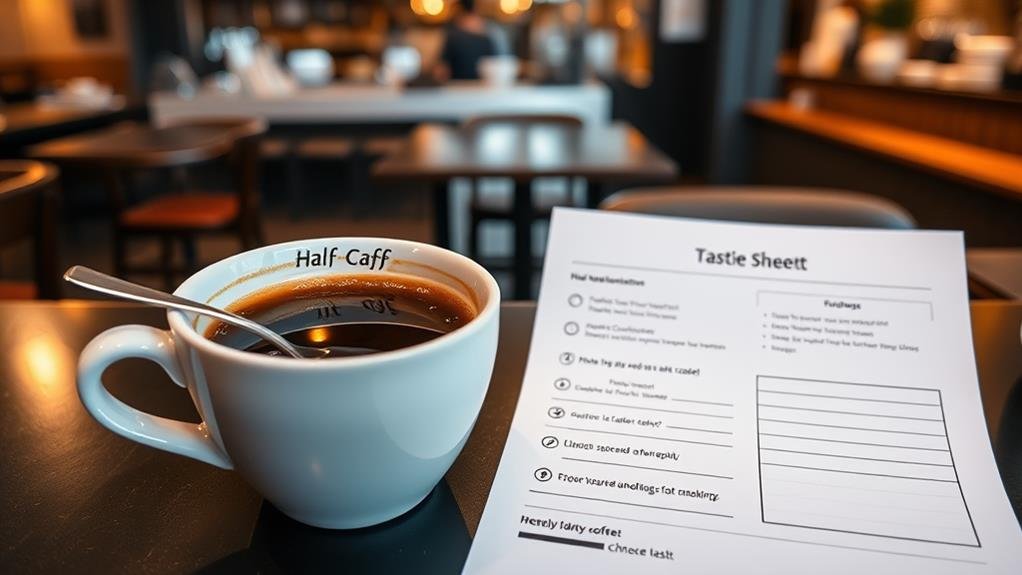
When it comes to cupping notes and adjustments, accuracy is key. To guarantee the best possible taste in your half decaf coffee, you need to be meticulous about every step of the brewing process. Weighing and timing your shots are essential for maintaining consistency and quality control. This means using a scale to measure the precise weight of your coffee grounds and a stopwatch to monitor the extraction time.
Visual cues also play a significant role. Observe the shot as it brews, using your intuition to make any necessary adjustments. For example, if you notice that the shot is coming out too fast or too slow, you can adjust the grind ratio accordingly. Developing a reference guide based on shot weight and timing helps in achieving accurate results consistently.
During the brewing process, keep an eye on each stage with your stopwatch. This allows you to maintain control over the extraction process and make fine-tuned adjustments based on what you observe. Use shot mirror observations and measurements to adjust your technique, making sure that each cup of half decaf coffee meets your desired standards. By following these steps, you'll be able to craft a perfect cup every time.
Common Blending Mistakes
Blending half decaf coffee can be challenging, and I often find myself making errors that impact the final brew. Here are some common pitfalls to watch out for:
- Uneven Bean Ratios: Using inconsistent proportions of caffeinated and decaffeinated beans can result in irregular caffeine levels in the final brew. This can make one cup notably different from another.
- Grinding Together: Grinding regular and decaf beans together can lead to varying flavor profiles and extraction rates. It's better to grind them simultaneously to guarantee consistency.
- Incomplete Mixing: Failing to thoroughly mix the beans before brewing can result in a brew that lacks balance in taste and caffeine content. A well-blended blend is essential for a harmonious cup.
- Overlooking Brewing Parameters: Not adjusting brewing parameters like grind size and extraction time for a half decaf blend can lead to mediocre coffee quality. Each blend may require unique settings to bring out the best flavors.
Customizing Your Half Caff Blend
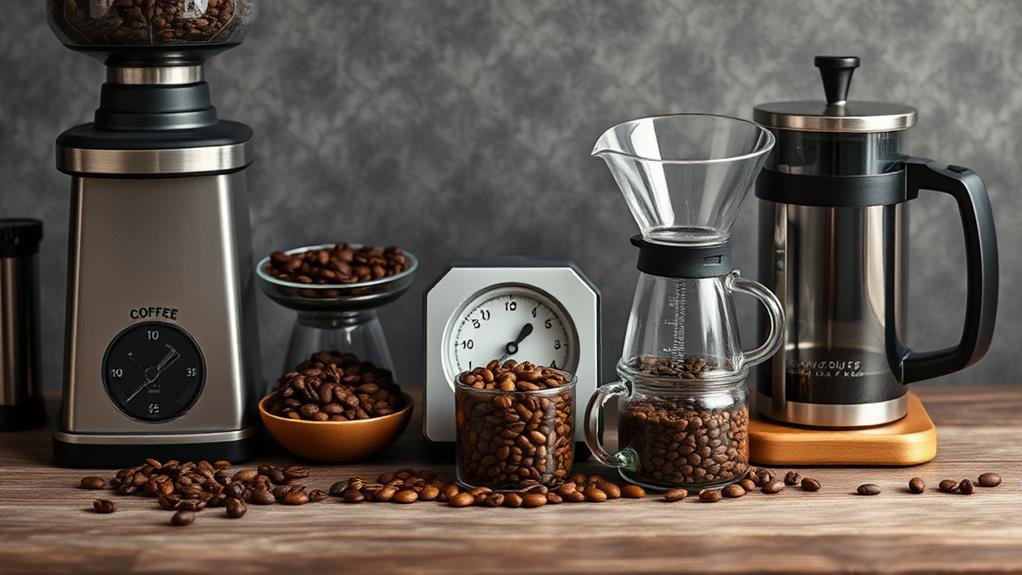
Customizing your half caff blend is all about finding the perfect balance that suits your taste. To start, you'll want to mix equal parts of caffeinated and decaffeinated beans. This guarantees you get the right amount of caffeine while maintaining a rich flavor profile. It's vital to grind these beans together before brewing to achieve an even distribution; this step prevents any unevenness in your coffee's taste.
Using high-quality decaf beans is necessary, as they will help maintain the overall flavor of your blend without sacrificing quality. You don't have to stick to one origin or roast level; experimenting with different ones can create a unique half caff experience tailored to your preferences.
Tips for Consistent Quality
To maintain consistent quality in your half decaf coffee, it's important to uphold a few key practices. Here are some tips to help you achieve that perfect balance:
- Use the same type of beans: For consistency in flavor, it's essential to use the same type of beans for both your caffeinated and decaf coffee. This guarantees that the flavor profile remains uniform throughout.
- Grind equal parts together: When brewing, grind equal parts of caffeinated and decaffeinated beans together. This step is crucial for creating a balanced blend.
- Avoid bulk mixing: Mixing beans in bulk can lead to uneven distribution of caffeine content. Instead, mix them just before brewing for better control over the final product.
- Opt for high-quality decaf beans: High-quality decaf beans are necessary to maintaining the taste of your half caff coffee. They ensure that you don't sacrifice flavor for reduced caffeine.
Conclusion
Making half caff coffee is like hitting the perfect chord in music – it's all about balance. Just as a musician adjusts notes to create harmony, you tweak the grind and brewing time to find that ideal mix. I recall one morning when my grind was off, and the coffee tasted bitter. Adjusting the grind size fixed it, reminding me that small changes can make a big difference. With practice, you'll master this blend and enjoy a smooth, consistent cup every time.

